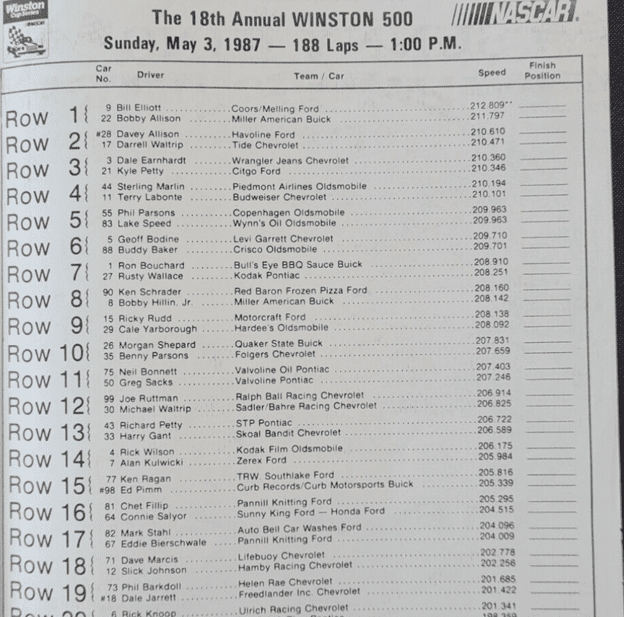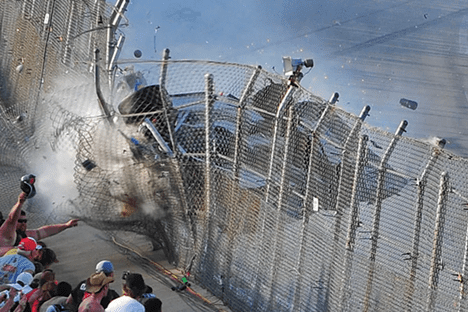1986 Curb made a commitment to run Buicks, but rumors had Buick bringing out the Le Sabre as the 1987 NASCAR approved model, the Curb management collective chose to wait until 1987. Racers always have an improved idea, our “mind’s eye” always challenges our aero interpretation at best. The 1983 T-Bird was the first car that NASCAR allowed us to stretch to fit the chassis. In 1986 we ventured into one-piece fabricated sides, eliminating factory door skins. We now as a collective of fabricators broadened our car building skills. NASCAR had moved into a new generation of custom fabricated bodies. The skill level of the metal workers, and the knowledge of the aero engineers associated pushed performance. Teams that had the best fabricators, best fab equipment fueled the imagination, and the imagination fueled the ability to win.

The change included getting a Buick ready for Talladega. The first generation had teams scrambling, there was a lot of surgery to put the front ends together. The straight-up OEM front end was wide, flat nosed. As a reference for the Talladega Buick, the Bobby Allison Buicks were the benchmark. I knew a few homies on that deal, and we traded information back and forth. The trick of the day was narrow, word was Bill Elliott’s tread width at Daytona was 57 inches. This took a lot of engineering/ chassis fab to take advantage of this, we had the “want to” but our archive of parts was limited at best. At the end of the day, we had a 58” rear track, and 59” front track. The brake system was lightened up, every aspect of alignment was perfected, rolling resistance was optimized, every rotating component was weighed and optimized, as for narrow, better but not the least by any means. Many argued the flat front OEM bumper and cover facia/ air dam combo was two wide. Creative fabrication allowed teams to narrow the front end from the hood that covered the wheels down to the air dam. Teams pie cut the aluminum bumper, urethane facia, and fabricated aluminum air dam giving the front end a T-Bird style front end. Buick involvement was limited, no wind tunnel, just tons of pictures of Buick teams, we rolled into Talladega confident. Pimm was an intuitive smart racer, after being around Chet Fillip, Pancho Carter driving Hamby’s car, and Robert Harrington’s Tom Sneva notes the team created a driver profile. Carlise Johnson felt that the car had to be tight/ lot of grip to benefit the Indy style of driving. I toyed with the concept from watching and/or racing Bobby Allison. He raced folks on super speedways with a complement of air, his approach to some racers was pushing air aggressively, their reaction gave him a chance to control the situation, others he politely advanced, the control of the blanket of fluid was amazing to watch. Later, I saw Dale Earnhardt take command of the same skillsets. I have found over the years that communication is the key, the Johnson team worked with the best racers at Hickory Speedway, their claim to fame was building great cars for established race drivers. Communicating with drivers from a different form of racing was outside their circle of knowledge. Pimm communicated and asked questions that were not evident in Winston Cup racing. Indy race engineering started a narrative that complemented tire grip, this included practices that were not illegal in NASCAR just outside of our imagination. For the 1987 Daytona 500 I helped build two cars, one the communication was open with a plan, the other was preparation with no plan of action. At the end of the day both had engine failures, one was in the Daytona 500, the on-track performance was totally different, and every challenge of the day could have been fixed with simple communication. At Talladega, Pimm was stronger, faster, smoother, the car was lightyears better than Daytona. Carlise had a tick in his personality that I had seen in multiple old school crew chiefs that prepared winning cars, the car was not the issue. Ed had zero stockcar experience, in fact he was more concerned we eat fried chicken with our fingers, and why NASCAR didn’t have hospitality sweets for the wives. But he did have questions that in time that would define wins in NASCAR future. Why didn’t we camber our rears, why aren’t we concerned with the body roll upsetting aero, why didn’t we stagger track the cars to the left or right to enhance aero? I parroted things to him, Herb, Jake, Boobie, Hutch, Roland, Richard all said at Talladega, the narrative led back to any car he ever drove that steering effected speed, steering wheel motion bound the car, that the sound of the engine straining was a warning, tires gripping too much used energy and ate up speed. Understand the mechanics of a 3500lb object falling off a 4-story building, and how to get there without using all your energy up, realize that NASCAR measures the track at 11 ft from wall, Talladega was 2.66 miles, and the speed was calculated there, but the time was measured from a line across the track. The shortest distance was around the bottom the faster the better. I added one for me, you can’t race if you don’t qualify, in practice you need to study your path, running in a draft is a matter of talent, to qualify you must stick to a mechanical plan. Think about changes that make your job easier, qualifying first, racing changes second. The Johnson team was rattled, the weight of the performance was riding on a dream, to prove he could be a successful Winston Cup Crew chief and top-class engine builders. Carlise was solid, but they had one bad habit they measured folks from when they started, I heard more than one occasion that Mike Beam was a tire store punk, he had no racing experience. I knew the concept well, I have always been a good car painter, and Mike Beam had his issues also. Practice was a typical Curb Racing deal; we had 4 sets of bias ply tires mandated by management for the race. Rolled through inspection, shook the car down, 198 consistent in traffic, second practice worked on race set up, put on second set for qualifying run 201, looked like everyone was over 200 mph. Practice sheets showed a grim tale, looked like 201 mph wouldn’t ring the bell. As we prepped for the second round, I told Pimm to hit his marks, he said what ever that meant. I told Ed that I had the last set of tires on with about 5 pounds over the last run, and I raised the track bar ¼ on both sides as per Carlise, I told him stay off brakes, we would ease the car to the starting line, that the car would be freer, to hunt the place where he was going to be on the edge. At the end of the day Ed popped off a 205.339 lap, as he rolled in, he was out of breath, totally blood flushed. He said put it back where it was.

The race was a historic event on many levels, Bobby Allison was running in a crowd as he got right in front of our pit, he dumped a harmonic balancer / broke end of the crank off, this hit the fuel cell can, ricocheting to blow out right rear tire a sending the car into the fence backwards. The wreck scattered junk everywhere, after a class in building a racetrack fence, we rolled the field. Within minutes Micheal Waltrip in the 30 car started a wreck he survived, but a number scattered junk on the track. Ed said he missed everything but a few laps he smelled water, the day ended with a Bahari screwdriver stuck in the radiator.
